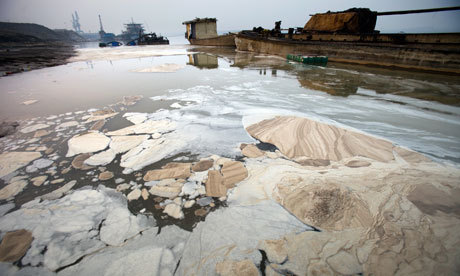Chemical waste disposal to be completed by year end
Millions of tons of chromium residue from chemical manufacturing has been deposited across the nation, posing a grave threat to farmland and groundwater.
 |
|
Chemical waste water discharged into the Yangtze River from the Anhui Tongling steel plant. [Lu Guang/Greenpeace] |
About 20 cites in the country are reported to have 6 million tons of chromium slag.
The toxic waste is a by-product from chemical plants, which mushroomed in the 1950s. After the pollution came to light, the central government ordered more than half of them to close in the 1990s.
However, although production ended, the chromium residue remains.
The Dahe Daily in Central China's Henan province reported that there are six "hazardous fortresses" in Henan, containing 500,000 tons of the toxic chemical sealed inside concrete structures.
In Beisi village of Henan's Gongyi city, there is a stockpile of 50,000 tons of chromium slag that has stood 3 kilometers away from a river for almost 20 years.
The "fortress" is located in a ravine between two hills and the nearest houses are several kilometers away, according to a China Daily reporter at the site on Tuesday.
Local officials said the residue was from a local plant, which began to manufacture the industrial chemical chromic anhydrid in 1976.
After local residents complained about the potential hazards of the residue, in 1990 the factory was forced to store the slag in the more remote Beisi village.
In 1992, the factory was shut down but the residue is still there.
"I didn't know we faced such a potential threat," a herdsman, surnamed Zhuang, told China Daily.
Another villager, who wished to remain anonymous, said: "We are worried whether the residue is harmful. I hope the government takes steps to get rid of the hazard as soon as possible."
Chromium can lead to cancer in the lungs, liver and kidneys. A dose of five grams can kill a person, according to the National Institute of Occupational Health and Poison Control under the Chinese Center for Disease Control and Prevention.
"The residue was sealed in cement and has never leaked. We also supervise changes in the surrounding environment every year," Dong Yuanhui, deputy director of Gongyi environmental protection bureau, said on Tuesday.
Dong said a chemical company has won the bid for the disposal of the residue and the project will begin in either late November or early December.
"When the project starts, there will be a capacity to dispose of 300 to 400 tons of slag every day and all the hazardous chemicals will be gone in three to four months," Dong said.
In response to the potential harm chromium residue posed to people and the environment, in 2005 the State Council ordered local governments to deal with the disposal of the chemical waste within five years.
About the same time, there was an overhaul of the country's chromate industry. Out of more than 70 manufacturers, there are now only 18 still in operation, which are capable of safely disposing of the chemical residue.
According to an article on the official website of the Henan Environmental Protection Bureau, the province had disposed of 55,000 tons of chromium residue by the end of 2009.
Meanwhile, the disposal projects in Gongyi, Xinxiang and Anyang cities have yet to begin, the article said.
Officials said it was difficult for them to deal with the residue on time.
Accounting for the project's inefficiency, Shao Fengshou, head of the solid waste management office for the Henan environmental protection bureau, said the central government had asked local governments to pay for the disposal of chromium residue, while they wanted to be subsidized by the central government for doing so.
The subsidies were not completely allocated until July and had affected the progress of the waste disposal projects, Shao said.
Henan needs 230 million yuan ($34 million) to deal with the chromium residue throughout the province, but the central government has only allocated 111 million yuan, officials said.
 0
0 







Go to Forum >>0 Comments